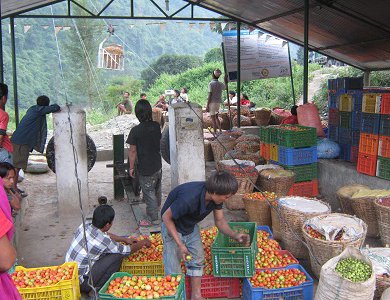
At a time when rampant construction of the rural roads in various parts of Nepal is wasting resources and increasing the dangers of landslides, the government officials have come to realize that the gravity ropeways are likely to be good transport alternatives.
After learning from the positive impacts generated by gravity ropeways in various parts of Nepal, the policymakers are pursuing the alternative that the Practical Action had been promoting and implementing.
"Given Nepal's fragile mountain eco-system and high cost involved in the construction of roads, the National Planning Commission is pursuing the construction of ropeways as an alternative to the rural roads. Although I have yet to visit any gravity ropeway site, I was told by officials from the Practical Action about their successful model of gravity ropeways and that they helped the communities to transport their goods," said Gopi Mainali, joint secretary at the National Planning Commission and head of the infrastructure division. “While travelling to Pokhara, I noticed ropeways were carrying vegetables and goods to the road sides. Given its cheap cost and environmental friendly feature, the National Planning Commission has proposed these kinds of ropeways in its current interim plan.”
Although Nepal started the ropeways almost over a century ago to carry goods, this mode of transport has rarely got any priority in the government programs. Given Nepal's topography and nature, the rope is regarded as the best option for transporting goods in terms of environmental sustainability and construction cost.
However, it took almost decades to revive the ropeways as important mode of goods transport in the minds of the people. The credit of reminding the importance of ropeways and its importance goes to the Practical Action, an UK based INGO. Under the Access for Opportunities project, 2007 to 2012, Practical Action installed 15 Gravity Goods Ropeways in 4 districts of Nepal.
"Gravity Goods Ropeway (GGR) is one of the flagship technologies of the Practical Action, Nepal office. It fits well with the rugged topography and agrarian economy of Nepal. It taps the undulation of ground to overcome the inaccessibility posed by it. It helps farmers to get their products to market in less time, cost and drudgery. It was introduced in Nepal in 2000 for the first time. Now, the technology is heading towards achieving the impact at scale," said Rabindra Bahadur Singh, project manager of Practical Action. "We are making concerted efforts for the wider replication of the technology by influencing and building the capacity of other organizations."
There are realizations in policy making level that gravity ropeways can be used in the rural poverty alleviation programs given its success to raise the income in poor Chepang communities in Dhading and Gorkha districts.
"I have not visited any site and got the first appraisal of the development and change brought by gravity ropeways. I came to know how successful use of gravity ropeways helped eradicate poverty from the rural parts of Nepal when I was in the National Planning Commission. Now I am working in the Ministry of Cooperatives and Poverty Alleviation and we are considering using gravity ropeways to eradicate the poverty.”
The Department of Local Infrastructure Development and Agriculture Road (DoLIDAR), which oversees all the infrastructure development works at the local level, has started to replicate the technology in Nepal. Last year, it carried out feasibility study for GGRs on 21 sites in 9 districts. "Practical Action provided technical training to its engineers, consultants and verified the feasibility reports. It has also started installation of GGR at 2 sites. Practical Action and the department have agreed to work together to explore the leverage fund for the replication of the technology in Nepal," said Singh.
"Gravity ropeways has proven its worth. We are working to install ropeways in some parts of Nepal taking the expertise from and sharing the knowledge with the Practical Action," said Bhim Prasad Upadhyaya, acting director general of the Department of Local Infrastructure Development and Agriculture Roads (DoLIDAR).
Likewise, the Practical Action has started to replicate the technology outside Nepal through Practical Action Consulting. They have been providing technical assistance to Tarayana Foundation Bhutan to install a GGR in Bhutan. The Agriculture Machinery Centre (AMC) Bhutan is also interested to take up the technology.
"To support and sustain wider replication of the technology, human resource development is really important. Realizing the fact, Practical Action has been closely working with Pulchowk Engineering Campus, the largest and most reputed Engineering College in Nepal. The college has included the GGR technology in their curriculum and started to run elective classes on it for its Bachelor of Civil Engineering final year students. Practical Action supported the college to develop curriculum and has been providing resource persons to facilitate the classes," said Singh.
Thanks to successful installation by Practical Action, there are indications that the GGR is well on its way to achieve impact at scale. However, there is still a long way to go. There is also a risk of losing the momentum if we fail to continue the proactive efforts from our side.
- TANAHU HYDROPOWER PROEJCT: A Significant Achievement
- Apr 15, 2024
- AMBASSADOR HANAN GODAR: Sharing Pain With A Nepali Family
- Mar 30, 2024
- VISIT OF KfW AND EIB TO NEPAL : Mission Matters
- Mar 25, 2024
- NEPAL BRITAIN SOCIETY: Pratima Pande's Leadership
- Mar 24, 2024
- NEPAL ARMY DAY: Time To Recall Glory
- Mar 15, 2024
















